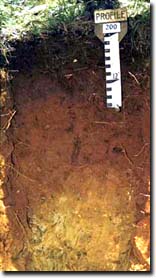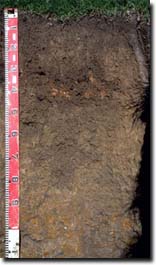Victorian State Soil Contender - Brown Dermosol

Back to: Contenders for State Soil
Why should the Brown Dermosol be Victoria’s State Soil?
Poem: 'The Surface of a Soul'
|  Brown Dermosol typical of mountainous areas in the eastern highlands of Victoria. |
| Typical soil profile This profile is of a Brown Dermosol formed on Cretaceous hills in the Strzelecki ranges. |  Brown Dermosol in the Strzelecki ranges. | ||
| Surface Soil | |||
| A11 | 0-15 cm | Dark greyish brown; silty clay loam; very strongly acid (pH 4.8) | |
| A12 | 15-35 cm | Brown; silty clay loam | |
| Subsoil | |||
| B21 | 35-60 cm | Yellowish brown; light clay; moderate polyhedral structure; very strongly acid (pH 4.7) | |
| B22 | 60-80 cm | Pale brown; light medium clay; moderate polyhedral structure | |
| B23 | 80-100 cm | Pale brown; medium clay; very strongly acid (pH 4.7) | |
| C | 100 cm+ | Weathered sedimentary rock | |


